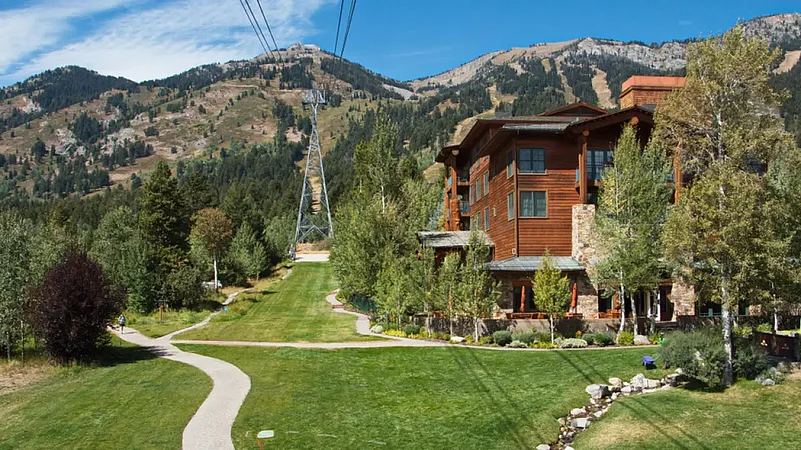A half-hour drive or so from the resort where the high priests of international finance — leading economists and central bank officials — have convened in Jackson Hole, Wyoming, to discuss the world's economic challenges, Ash Hermanowski oversees the distribution of about 1,200 free meals a day.
At a food bank called Jackson Cupboard, Hermanowski hands out meals from a commercial garage after being forced from a previous site by a malfunctioning sprinkler. The food bank couldn't afford any other place in town.
Just across the street, The Glenwood, a collection of townhomes that will sell for millions, is nearing completion. "Unparalleled luxury", its website says, in a “truly relaxing oasis".
Advertisement
It's the “ultimate irony,” Hermanowski said. “The staff and I, we talk about it all the time. We all struggle to live here, and they're building high-end residences. That dichotomy exists all over town, but people refuse to see it.”
As the Federal Reserve's annual economic symposium gets under way on Thursday at a lodge in Grand Teton National Park, some of the very problems Fed officials are grappling with — high inflation, soaring rental costs and home prices and wide economic inequalities — can be found near the idyllic mountain setting.
On Friday, Fed Chair Jerome Powell will deliver a speech that could signal how high or how fast the central bank may raise interest rates in the coming months. Powell's remarks will be scrutinised by Wall Street traders and economists and could potentially cause sharp swings in financial markets.
Advertisement
In its drive to tame the worst inflation bout the nation has endured in four decades, the Powell Fed has embarked on its fastest series of rate hikes since the early 1980s. The Fed is trying to slow the economy just enough to cool inflation without causing a recession — a notoriously delicate task.
Inflation is particularly high in the town of Jackson and the surrounding Teton County, which, even before the pandemic erupted two years ago, was the wealthiest and most unequal place in the nation. (Jackson Hole is the name of the broader valley.)
The state of Wyoming has calculated that the cost of living in the county at the end of 2021 was 68 per cent higher than in the rest of the state — with housing costs 130 per cent higher.
At the food bank, Hermanowski says, demand has escalated from a year ago as surging food and gas prices have sapped the budgets of their clients.
Roughly 85 per cent of the food bank's recipients have a job, often more than one, said Sharel Lund, executive director of one22, a nonprofit that includes Jackson Cupboard.
Like many resort towns, Jackson has always been expensive. But the pandemic turbocharged the disparities that have widened the gap between the wealthy and everyone else. Real estate prices soared as many affluent families, seeking to escape crowded cities, moved into the Jackson area or spent more time at vacation homes they already owned.
Advertisement
With many office professionals able to work remotely, the area's natural beauty became an alluring draw. Wyoming's low-tax status has also proved appealing to high-income earners.
Jackson, a town of about 25,000 people year-round, still retains its aura as an old Western town, with its archways made from elk antlers around the town square. The square is lined with a “Cowboy Bar” and an old-timey “Five and Dime” shop.
Yet wedged in among such outlets are symbols of the increasingly luxe Jackson: High-end jewelry shops and a Swarvoski crystal store that is selling a bald eagle figurine for $9,600.
“We definitely see both sides of it here,” said Hannah Cooley, executive director of Hole Food Rescue, a nonprofit that redistributes leftover food from restaurants and bakeries. “You have the ultra-wealthy with their massive houses. And then you have three immigrant families crammed into a one-bedroom apartment.”
Advertisement
Already-high home prices and rents in Jackson have jumped further since the pandemic, just as they have nationally, a particular hardship for people who work as housekeepers, chefs and waiters at resorts. The median price for a home: $3 million, twice what it was five years ago. The average apartment rent in Teton County jumped 12.4 per cent last year, to $2,780, according to state government data.
Jonathan Schechter, a member of Jackson's Town Council, says that according to the most recent IRS data, the average income in Teton County in 2019 was $312,442, highest in the nation and nearly 50 per cent above the second-highest, Manhattan.
Advertisement
April Norton, director of the Jackson/Teton County Affordable Housing Department, points to a major obstacle to home construction: 97 per cent of the county's land is federally owned and can't be developed. Compounding the squeeze, retiring workers who bought homes at affordable prices decades ago are now selling them for eye-popping prices that many current workers, even higher-income professionals, can't afford.
The county is trying multiple approaches to address the shortage of affordable housing. They include building homes available only to people who work locally and with caps on price appreciation. Such “deed-restricted” homes have still sold for more than $700,000, evidence of the intense demand and limited supply.
Advertisement
Still, a county report shows there is a waitlist of roughly 1,500 families seeking affordable housing, up from 1,100 last year.















 Just one email a week
Just one email a week